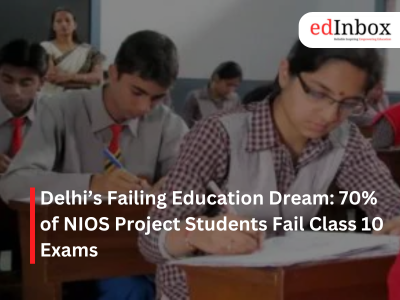A shocking report by the Directorate of Education (DoE) has revealed that nearly 70% of Delhi government students enrolled under the NIOS Project failed the Class 10 examinations over the past four years. The project was initially welcomed as a second chance for students who failed Classes 9 or 10. However, it is now facing heavy criticism for poor execution and a lack of accountability.
A Scheme Meant for Dropout Recovery Falls Short
Launched by the Delhi government to help students reappear for their Class 10 exams through the National Institute of Open Schooling (NIOS), the initiative aimed to reduce school dropout rates. However, official data accessed through an RTI reveals an alarming failure trend, signalling deeper cracks in what was once praised as Delhi’s “inclusive education model”.
In 2024, of the 7,794 students who turned up to take the Class 10 exam under the NIOS project, only 37% (2,842 students) passed. The enrolment figures always stayed between 10,000 and 29,000 a year but the overall pass percentage has been around 30 percent over the years despite this being an indication of inefficiencies in the system.
Why Are Students Failing?
Many government school teachers in Delhi have attributed the failure and most of them attributed the failure of the project to lack of coordination and mentorship.
- Weak parent-teacher communication: The parents of registered students are seldom informed of the attendance or progress.
- Few checks: students receive little academic monitoring or individual guidance..
- Poor attendance: There is low involvement of students, as most of them are not followed up regularly and lack support nets after admission.
These structural flaws have turned a good idea into another administrative trifle and put students at a loss without encouragement.
Costs Beyond Performance
Based on the existing system, registration charge of five NIOS subjects is 500 with an extra 200 per subject, 120 per practical subject and 230 per credit transfer. Also, the price is considered affordable, but students with low incomes will not be able to afford it, particularly when the system does not offer a lot of academic support.
A Greater Crisis in the Delhi Education Model
The results contribute to the current backlash against the model of education in Delhi, which many politicians and analysts now criticize as all show and no substance Some reports also indicate that the level of learning and literacy in government schools is still way below standards despite such enormous investments. By 202324, even more than one lakh Class 9 and fifty thousand Class 11 students failed in government schools. This also revealed how academic reforms have not been able to produce meaningful learning outcomes.
What Do Experts Say?
Education analysts say that the Delhi model of reform should be rebooted- a reduction in emphasis on marketing slogans and the increase in student-teacher contact, teacher mentorship, teacher responsibility.
The 70% failure rate of the NIOS project is a huge reminder that the process of reforming education is not merely a question of access, it is a question of continuous quality and direction. These management loopholes, unless filled by the policymakers of Delhi, will continue to be a mere political sentence rather than an actual situation in the city of Delhi, which promises a fair and global education system.
Delhi’s Failing Education Dream: 70% of NIOS Project Students Fail Class 10 Exams
Typography
- Smaller Small Medium Big Bigger
- Default Helvetica Segoe Georgia Times
- Reading Mode

